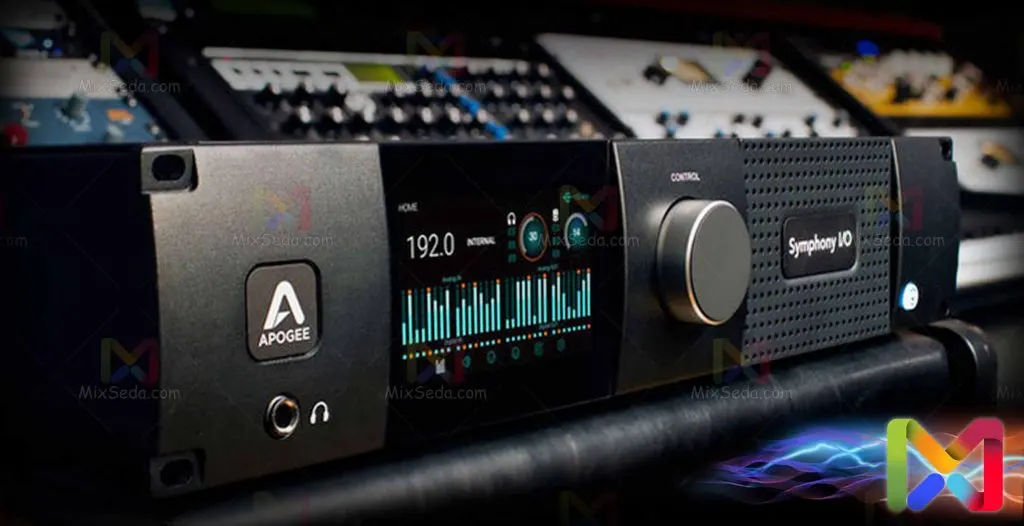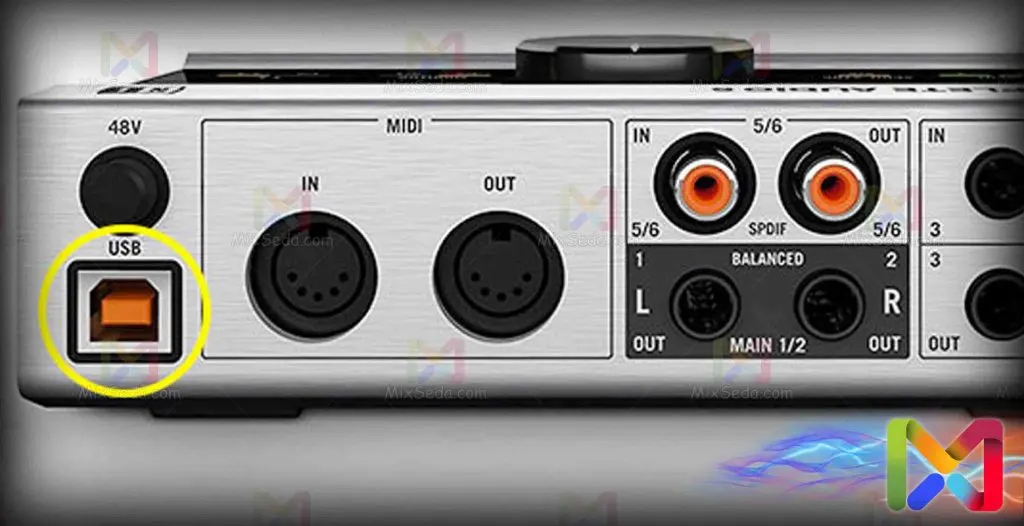
Choosing the right audio interface may seem a little overwhelming. There are all kinds of different input and output configurations, connection types, formats and many other options to consider.
So, how do you find the right one for you? This Mixseda Buying Guide will help you navigate the choices you need to make so that you find the interface that best meets your needs.
What is an audio interface?
An audio interface is the hardware that connects your microphones and other audio gear to your computer. A typical audio interface converts analog signals into the digital audio information that your computer can process. It sends that digital audio to your computer via some kind of connection (e.g. Thunderbolt, USB, FireWire, or a special PCI/PCIe card).
This same audio interface also performs the same process in reverse, receiving digital audio information from your computer and converting it into an analog signal that you can hear through your studio monitors or headphones.
Most audio interfaces include line-level analog inputs and outputs, one or more microphone preamplifiers, and may even include digital inputs and outputs such as AES, S/PDIF or ADAT (Lightpipe).

Why do you need an audio interface?
There are several reasons to use a dedicated audio interface, rather than the sound card built into your computer. Technically speaking, a sound card is an audio interface, but its limited sound quality and minimal I/O make it less than ideal for recording.
Many sound cards only have a consumer-grade stereo line level input, a headphone output, and possibly also a consumer-grade stereo line level output. Electromagnetic and radio interference, jitter, and excessive latency all degrade or negatively affect audio both on the way in and on the way out.
It’s also impossible to track a full drum kit (let alone a full band) with only two channels of input. Sound cards are great for hooking up a pair of Hi-Fi speakers and playing back compressed audio, but you’re going to need a reliable audio interface for recording and monitoring production-quality audio.
Choosing the right I/O configuration
With the possible exception of computer connectivity (more on that below), no other feature is as important for choosing your audio interface as its I/O (input and output) configuration.
The number and type of inputs and outputs you need depends entirely on what you want to be able to record, now and in the future. The range of audio interfaces includes everything from 2-channel desktop units to systems that can record hundreds of channels.
If you’re a singer-songwriter, than you may only need a pair of inputs, as long as they’re the right inputs. Most audio interfaces include two or more microphone preamps.
If you’re going to use condenser microphones you’ll want to make sure that your interface’s preamps are also equipped with phantom power. If you’re going to plug your guitar or keyboard straight into your interface, make sure that the interface you buy has instrument-level (also called “hi-Z”) inputs.
Line-level inputs and outputs are great for hooking up outboard processors, headphone amps (for creating separate headphone mixes) and studio monitors.
Digital I/O may not seem important when you’re first starting out, but it can be incredibly useful down the road. For instance, some high-end 1- or 2-channel microphone preamplifiers come equipped with digital outputs, which lets you hook them up to your audio interface without depriving you of line-level inputs.
If your interface comes equipped with standard ADAT lightpipe I/O, you can easily expand your system with an ADAT-equipped 8-channel mic pre. Eight extra channels can turn your personal recording rig into a system that’s ready to track a full band.
Computer connectivity options
One of the constants of the recording industry is that technology doesn’t sit still for long. In computer-related technology “standard” is next to “obsolete.” That said, a few audio interface connection types are considered standard, and those are: Thunderbolt, USB, FireWire, and PCIe.
Most PC and Mac computers come equipped with USB ports (either USB 2 or USB 3), whereas FireWire (either 400 or 800) is mostly found on Macs. Both of these protocols average the same speed (480Mbps), which is fast enough to record up to 64 tracks at once under ideal conditions.
Also, there are some simple interfaces that still use USB 1.1, which is much slower, but fast enough to record one or two channels.
Thunderbolt
Due to its incredibly high speed and low latency, Thunderbolt is the new reference standard for connecting audio interfaces. Thunderbolt 3 (found on the latest Macs) is twice as fast as Thunderbolt 2 and 8 times faster than USB 3, supporting speeds up to 40 Gbps and cable lengths of up to 100 meters using optical cable.
There are many high-end interfaces that now support Thunderbolt.

Firewire
The advantage of FireWire is that it transfers data at more consistent rate than USB, which makes it slightly more reliable when you’re recording more channels at once.
The disadvantage is that there are less interfaces that use FireWire than USB, and less computers that come equipped with FireWire ports. If you own a PC, you might need to install a FireWire card.

USB
The advantage to USB (3.0, 2.0, and 1.1) is that there are many interfaces designed to run on USB bus power (rather than an external power supply), which is excellent if you plan on doing mobile recording with your laptop.
There is also a small selection of PC Express and PCMCIA card-based interfaces, which are specifically designed for laptops.

PCIe
That brings us to the fourth standard audio interface connection, which is PCIe (PCI Express). PCIe is an internal card-based interface, which (by its very nature) means you can’t use these interfaces with laptop computers.
By effectively installing your audio interface into your computer’s motherboard, you gain the advantage of bypassing some of the data conversion processes that cause latency and limit bandwidth.
The majority of PCIe audio interfaces are designed to handle high track counts and the near-instantaneous speed required by professional studios, and are consequently more expensive than FireWire or USB interfaces.
That said, there are some affordable PCIe interfaces that allow even entry-level users to take advantage of this format.

Tech specs and how to read them
People often ask us, do things like bit depth and sample rate really matter? They’re some of the specs listed with almost every interface out there. The answer isn’t simple, but yes, they do matter. Let’s start with bit depth. When it comes to processing audio, bit depth has a huge impact on your sound.
The simple math is that 1 bit = 6dB. That means 16-bit audio (CD standard) has a total dynamic range of 16-bits x 6 db/bit for a total of 96dB.
The problem is that the digital noise floor is pretty high, and the remaining dynamic range is pretty small. The result is that if you work at 16-bit, the quieter sections of your audio will tend to be noisy.
With 144dB of range, 24-bit audio gives production professionals the range they need to process audio smoothly. That’s why 24-bit is considered the professional standard and is highly recommended.
On the flip side, sample rate is much more subjective. Each sample is a digital snapshot of the captured audio. The CD standard 44.1kHz takes 44,100 digital pictures of the incoming audio every second.
Digital to analog conversion only needs two samples (the top and the bottom) of a wave form to generate a frequency, so the 44.1kHz sample rate is theoretically capable of reproducing frequencies as high as 22.05kHz. The uppermost range of human hearing (in young females) is 20kHz, so technically, 44.1kHz is more than enough to capture and reproduce every sound you can hear.
However, there are additional considerations (all of which are technical) that may or may not suggest higher sample rates capture valuable information. That’s why most audio professionals choose to work at 48kHz, 88.2kHz, 96kHz, or even 176.4 or 192kHz.
In the end, it’s all relative. If you’re planning on releasing your demo on CD or posting MP3s online you’ll probably be fine working at or mixing down to 16-bit/44.1kHz. If you plan to release jazz in a high resolution format, don’t even consider working at less than 24-bit/96kHz.
Higher sample rates, such as 192kHz are also extremely useful for sound design. Record a dog snarling at 192kHz, and import it into a 96kHz session (half the speed and pitch but no loss of resolution), and you instantly have the ominous guttural growl used in countless sci-fi monster movies.
Just remember, higher sample rates and bit depths eat up more disc space and limit your track count, so you’ll need to work within the limits of your equipment.
The most important thing to remember about sample rate and bit depth is that they are less significant than the quality of the digital converters you use. The same way that a soapbox derby car with a Ferrari engine in it may be able to go 130mph, but you wouldn’t want to be along for the ride, a low-end converter may do 24-bit/96kHz, but it’s not going to give you the professional fidelity you’re after.
If you’re interested in learning more about sample rates, digital converters, and digital audio in general, check out the excellent books in our Instructional Books section.
Additional considerations
Here are some additional things you want to keep in mind. First, although the list gets shorter every year, there are some audio interfaces that are Mac- or PC-compatible only.
At Sweetwater, we try to make this as clear as possible, so be sure to read the features section at the bottom of each interface’s detail page. Of course, if you’re still not sure, please feel free to call your Sweetwater Sales Engineer.
More and more interfaces include some kind of integrated software control and DSP for mixing. This feature is incredibly handy. Software mixing allows you to do everything from setting up headphone mixes, add reverb or delay to headphone mixes, and allow you talkback communication to the artists in the studio.
What’s more, software control over onboard DSP does all of this without adding latency, draining CPU power, or affecting your DAW software in any way.
